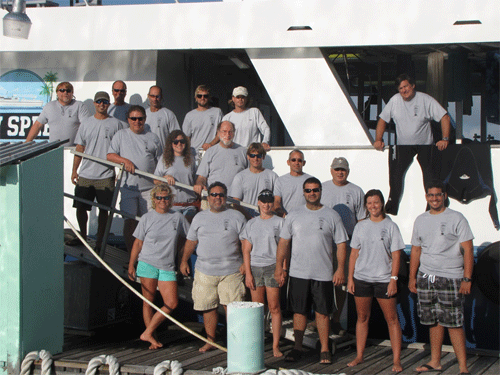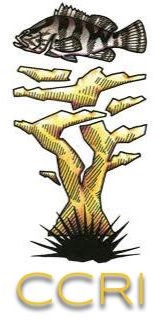A multi-site comparison on mesophotic reefs from Mona Island, PR to St. Croix, USVI
Sponsor: Caribbean Coral Reef Institute, University of Puerto Rico – Mayagüez
Collaboration: NOAA/NCCOS Center for Sponsored Coastal Ocean Research
Funding: NOAA Center for Sponsored Coastal Ocean Research
Vessel: M/V Spree, a 100-ft commercial dive vessel
The Players
- Richard Appeldoorn- ROV operations and project PI, shallow diver
- Ivonne Bejarano – Deep CCR diver (Week 1)
- Milton Carlo – Deep CCR diver
- Michael Dowgiallo – ROV team and shallow diver
- Thor Dunmire – Shallow CCR diver and Assistant Dive Officer
- Yahaira Hutchinson – Shallow diver and coral processing
- Elisabeth Kadison – Deep CCR diver (Week 2)
- Doug Kesling – Deep CCR diver and Chief Dive Officer
- Michael Nemeth – Deep CCR diver
- Daphne Pagan – Shallow diver, Invertebrate processing and genetics (Week1)
- Francisco Pagan – ROV operations and tech
- Luis Rodriguez – Shallow diver, invertebrate processing and genetics (Week2)
- Tim Rowell – Shallow diver, Blog
- Duane Sanabria – Shallow diver and coral processing
- Nikoloas Schizas – Shallow diver, invertebrate processing and genetics
- Clark Sherman – Deep CCR diver and Geomorphology
- Derek Soto – Shallow diver and coral processing
- Evan Tuohy – Shallow CCR diver, ROV
Objectives
Our two week mission: to explore strange new mesophotic coral ecosystems, to seek out new species and new communities, to boldly go where no man has gone before. This paraphrase from Star Trek seems appropriate as we are off to explore Inner Space, the last frontier on earth. We are interested to see how mesophotic coral ecosystems, or MCEs, vary relative to the steepness and geomorphology of the insular slope, the amount of sediment moving down the slope, and the historical exposure to waves and currents during the last sea level rise. The trip will take us to sites along the main Puerto Rico – Virgin Islands Platform, as well as to isolated islands and submerged seamounts. We will also collect corals and bottom samples to serve a variety of scientific purposes. Our primary tools are not those of the typical reef scientist, for the depths we will be working at are well beyond the range of typical scuba diving. Instead, we will use a combination of mixed-gas rebreather diving and a remotely-operated vehicle, or ROV. Our dive team will focus on detailed surveys of the benthic and fish communities and the targeted collection of specimens. The ROV will be used to extend those observations over a broader depth range, search additional sites, and at times collect a single sample with its one manipulator arm. Guiding our site selection, where possible, are high-resolution bathymetric images obtained from our colleagues at NOAA’s National Centers for Coastal Ocean Research – Center for Coastal Monitoring and Assessment and the Caribbean Fishery Management Council.
April 24th, 2012
As divers, graduate students, and researchers arrived to La Parguera in the morning for the third consecutive mesophotic cruise, the M/V Spree was ready for equipment to be loaded and prepared. By late afternoon, nearly all the final arrangements had been straightened out, and it was agreed that everyone would reconvene at 8:00pm for a captain, crew, and scientific briefing. At 8:30pm everyone had boarded the Spree and was together for the first time in the galley area. For many returning participants it was a reunion, and for first timers it was an opportunity to make a good first impression before everyone’s true colors would inevitably show themselves.
During the introductions we met Captains Frank and Zach, dive crew Melanie and Tim, and the all important galley crew of Chelyn and Tracy. Through the brief introductions, we gained a more in depth appreciation of how each crew member would play an integral role in ensuring the safety and success of this year’s cruise. Captain Frank did most of the talking, outlying the basic rules and procedures of the vessel. It became apparent that there were quite a few rules that would hopefully help maintain some sense of order and comfort during the trip. Frank’s presentation was a mixture of seriousness, satire, and good ol’ fashion comedy. Among the more amusing parts involved how to potty train adults on the use of the marine facilities, which would have had kindergartners rolling over laughing. The majority of us immature folks enjoyed it too. Melanie and Milton Carlo were next in line and informed us of the logistics of diving from the Spree. Richard Appeldoorn had the encore performance, playing such hits as the “Scientific Underwater Blues” and “Everyone’s Got a Helping Hand.” Rich addressed how each day would presumably work and how every person on the cruise would play an important role both inside and outside the water.
Finally, the tracks were laid for the first leg of the trip, which would leave Magueyes Island tomorrow morning at 5:00am in order to arrive at Abrir La Sierra at 8:00am. By the close of the day, everyone was in their bunks, learning who the snorers were and awaiting the work that would begin tomorrow.
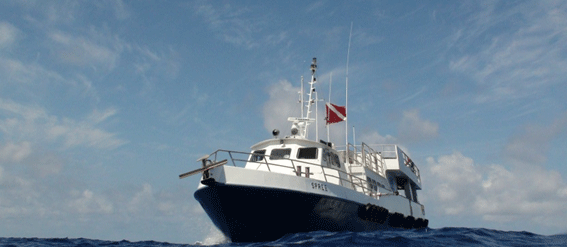
April 25th, 2012
Many were startled in their bunks as the engines fired up promptly at 5:00am, indicating that the day was starting on schedule and we were on our way to Abrir La Sierra, a seasonally protected area in Federal waters. Most pressed the mental snooze button until about 7:00am when the aroma of breakfast and the resonating meal bell made its way through the cabins. Many looked tired, but it quickly became apparent that the galley staff would keep us energized with a steady supply of hearty food.
Upon arriving at Abrir La Sierra a little after 8:00am, the re-breather divers confirmed their dive plan, donned their equipment, and hopped into the water at a deep offshore coral ridge. The team consisted of: two photo-transect enthusiasts Doug Kesling and Clark Sherman, the ethical coral collector Michael Nemeth, Miss Ichthyo-Hawk Eyes Ivonne Bejarano, and the master cosmopolitan diver Milton Carlo. The mission was to conduct a photo-transect, collect coral samples, and carry out a visual fish census at a depth of 50m (165ft).
The first indicator of the successful mission was a lift bag breaking the surface less than half way through the dive. The recovered lift bag granted gifts of good fortune to the invertebrate processors. Nick Schizas, Derek Soto, Yahaira Hutchinson, and Duane Sanabria lost no time in documenting and processing the invertebrate samples. Corals collected by the re-breathers included Agaricia lamarcki, Meandrina meandrites, Madracis sp., Porites astreoides, and Montastrea cavernosa. One species of sponge collected, Agelas conifera, is a dominant species at mesophotic depths and will be a focus during the cruise for studies on population connectivity. Samples of each specimen were preserved in ethanol for future morphological and genetic analyses. In addition, Yahaira took mucous samples for bacterial analyses. All samples will be important for comparison to specimens collected in different geographical and bathymetric locations. The rebreather divers reported surveying an outcrop of coral beyond the initial offshore ridge. Ivonne Bejarano witnessed many red hind, a few black grouper, and a couple cubera snapper.
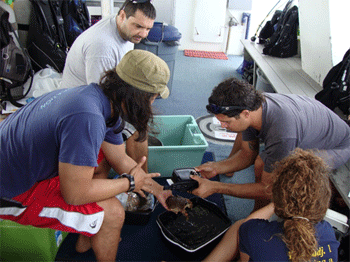
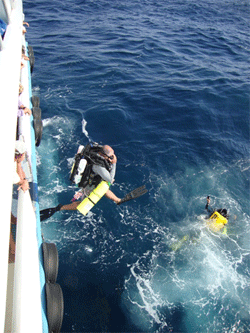
As sample processing continued, it was time for the first ROV (remotely operated vehicle) deployment of the cruise. With Richard Appeldoorn and Francisco Pagan behind the controls and Evan Tuohy, Michael Dowgiallo, Melanie, and Tim assisting with cable logistics, the ROV surveyed a 100m (330 feet) deep portion of Abrir La Sierra. The ROV located a second drop that warrants future inspection in upcoming ROV and re-breather surveys. A second ROV deployment was attempted after lunch, but due to a malfunction the mission was aborted. Francisco and Rich would work on determining and remedying the problem for the remainder of the day.
Finally, the itching shallow divers had their turn at jumping in the water after lunch. A group of 8 open-circuit divers and 2 re-breather divers surveyed a shallow area of Abrir La Sierra. Coral samples were collected for comparison to samples collected in deeper locations, and fish species were identified. A highlight of the shallow water dive, in addition to the successful retrieval of coral samples, was a friendly hogfish. While still an intermediate, this particular hogfish was near to maturity and expressed great adolescent confidence for the cameras. The larger fish species seen in the deep morning dive were not witnessed in the shallows, with exception of a few small red hind. However, large conchs were observed. The consensus was coneys and small reef fishes dominated the fish community at the examined shallow depth today.
Everyone is starting off on a good foot: safe and successful data collection, corresponding daily reports, and a lighthearted enthusiasm for today’s accomplishments. We have earned our dinner tonight. If we keep this up, tomorrow is expected to be an exciting and fulfilling day…
April 26th 2012
The boat pushed off from our anchorage at 5:30am and headed back out to Abrir La Sierra for a second day. The well fed rebreather divers entered the water at 8:30am. The target site for today’s rebreather divers was the secondary drop located with the ROV yesterday. After examining bathymetric data, it became apparent that this secondary drop runs to the south, where it becomes more prominent. The divers executed their objectives at this southern location at a depth of 70m (230ft). Agaricia spp. and carbonate matrices were lifted to the surface. The 10m photo-transect recorded a more developed deep reef at 70m than was seen yesterday at a shallower and more northern location. The photo-transects are composed of a series of 40cm x 60cm overlapping photos that will be stitched together using computer programs to generate a continuous view of a 10m long segment of surveyed reef. The resulting image will be used in comparisons to other sites and to determine community structure and how it varies across the US Caribbean.
Clark Sherman reported seeing a few rarely observed pastel soft corals, Neospongodes portoricensis. Pastel soft coral is a spectacular coral species known to inhabit depths too deep for traditional diving techniques. Luckily, we have re-breathers. This beautiful species was also observed yesterday during the ROV session at a depth of greater than 90m (290ft). The multiple sightings over the last two days indicate that this species has a foothold and ecological presence in the mesophotic zone at Abrir La Sierra. While more coral was observed today, large fish species were not, with the exception of one dog snapper and one mutton snapper. Maybe the large adult male hawksbill turtle seen at 30m (100ft) scared the large fish away. Likely not… but the scars on the large sponges likely can be attributed to resident hawksbill turtles.
Yahaira Hutchinson and Evan Tuohy sampled the carbonate complexes retrieved from the depths. Yahaira is interested in micro-crystallizing carbonates (micrites) and their role in helping consolidate sediments, creating the framework structure necessary for mesophotic coral colonization. As part of these analyses bacterial samples will be examined for evidence of precipitating and cementing capabilities. It’s interesting how geology in reef environments is being driven by biology and bacteriology.
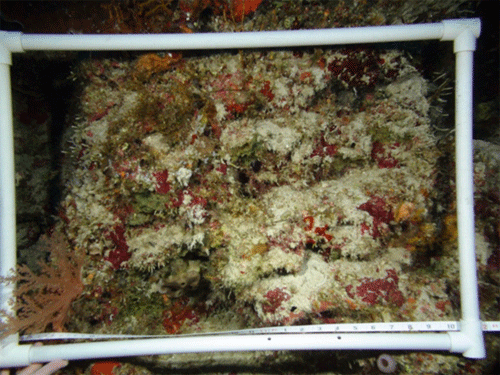
During the daily coral processing, Nick Schizas and team not only documented new specimens of Agaricia spp., but also many associated invertebrate species. Nick was overrun with minute crabs that inhabit the many folds of the platy agaricians. In addition, barnacles and copepods were collected for future work on invertebrate species associated with mesophotic coral habitats. Derek Soto and Duane Sanabria were so impressed that they might ask for sorting sieves next Christmas.
Due to continued problems with the ROV, this morning the shallow divers got in earlier and dove a shallow southern portion of Abrir La Sierra. The site today had higher concentrations of coral colonies than the site dove yesterday. Nick had no trouble locating specimens for his comparisons to deeper colonies. A variety of small reef fishes were prevalent, and schools of yellowtail snapper and French grunt were observed, as well as a large lionfish. A few juvenile conchs were observed amidst piles of harvested conch shells. It is apparent that this site has produced a lot of market size conch in the past. The shallow rebreathers, Evan Tuohy and Thor Dunmire, dove deeper than the rest of the shallow divers and observed the ominous presence of groups of large lionfish along the shelf break.
After lunch, work continued on trying to repair the ROV. Richard Appeldoorn, Francisco Pagan, and Evan Tuohy picked up where they left off last night at 11:30pm in order to locate the culprit of the malfunction. After multiple phone calls, the cause of the problem had yet to be determined. As a measure of security for tomorrow, the Spree steamed to the Port of Mayagüez this afternoon to receive and take aboard a spare ROV and parts gracefully provided by SEAMAP-Caribbean, a joint NOAA-Puerto Rico-US Virgin Islands program. As many of us work on daily reports and projects, work continued on the now dismantled ROV through the night.
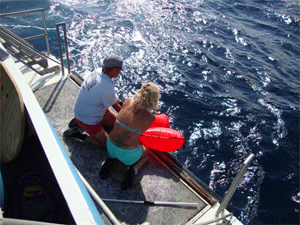
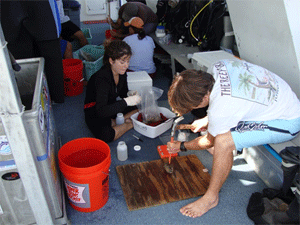
April 27th, 2012
Too early for flapjacks? Never. That’s right, after filling up on pancakes, bacon, and the usual continental breakfast items, the rebreather team advanced to the bottom of Bajo de Sico, another seasonally protected area off the west coast of PR. The change of scenery was welcomed, enabling the divers to carry out their usual sampling at the offshore seamount, which boasts higher coral cover and steeper slopes than seen at Abrir La Sierra. Among the coral samples lifted to the surface today were the most exquisite Agaricia lamarcki samples since the start of the cruise. Intermixed were more small crabs and a good amount of anxious brittle stars and isopods. After an initial steep drop from the top of the seamount, the divers reported locating a step in the downward slope at 180-220ft (55-67m) that continued downward at a gentler degree. On this mid-drop step, large coral colonized boulders were noted at 220ft (67m). A Montastrea cavernosa sample was collected at this depth, becoming the deepest specimen of M. cavernosa collected to date. The fish hunters, Michael Nemeth and Ivonne Bejarano, spotted an elusive small Nassau grouper, a large cubera snapper, and a large rainbow parrotfish. In addition, Michael observed nesting ocean triggerfish at 150ft (45m).
The diagnosis for the ROV was grim at the close of yesterday, with the main power board pinpointed as the culprit of the problems. As a result, the ROV team utilized the SEAMAP ROV today to explore the depths of the northwest section of Bajo de Sico. During the first dive, a black grouper was spotted patrolling a deep plain in 50m of water. Across this plain, patches of bioturbation were randomly scattered in remarkable quantities and of great interest to Nick Schizas; however, the source was not determined. Many will speculate on the source: stingrays, queen triggerfish, ocean triggerfish, or invertebrates? A second ROV deployment followed the southern slope of Bajo de Sico. Current conditions limited the ROV to a depth of less than 50m (165ft). However, the ROV covered a lot of area, recording distributions of Agarcia spp., Meandrina spp., Montastrea cavernosa, and black corals. Two black and one yellowfin grouper were spotted near a rocky ledge. Richard Appeldoorn behind the wheel even managed to master the ROV grabber to collect an Agaricia lamarcki specimen from 46m (150ft). His skills are maturing. Three unavoidable lionfish were spotted along an overhanging ledge at 46m.
The next stop was the protected waters of Desecheo Island. Yes, the waters surrounding the island are protected as a year-round no-take zone, and the island also provides much needed protection from the southerly swells and wind. What does this all mean? The shallow divers got to dive a site with calm conditions and better than average ecosystem health for PR. Richard Appeldoorn was amazed at the sizes of the parrotfish, Timothy Rowell was amazed at the size of schoolmaster, and in contradiction, Michael Dowgiallo was amazed at how small an individual green turtle was. In addition, Michael Dowgiallo noted multiple brown chromis with isopods, specifically Anilocra laticaudata, while not a single blue chromis had the external parasite. Michael enlightened us with the fact that blue chromis have autoimmunity to isopods in PR; brown chromis are not that luckily. Interestingly, the opposite is true in the Dominican Republic and has been well documented. A coney also had one of these pests, and studies have shown that PR is the northern limit of isopod autoimmune deficiency for coneys, i.e. more northern coney populations can fend off the isopods. Yahaira Hutchinson observed an unidentified flounder species as she glided over the sand towards the lively reef. The shallow rebreather divers spotted a dog snapper and a few large lionfish and red hind. In addition to the usual coral suspects to surface, Daphne Pagan collected rose lace coral, Stylaster roseus, for her genetic research. All divers were impressed at the high densities of fish and live coral. It is possible that the year-round protections implemented in 2000 have had positive results.
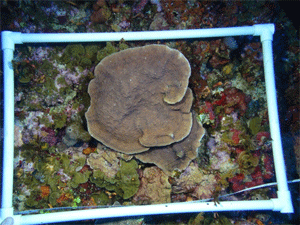
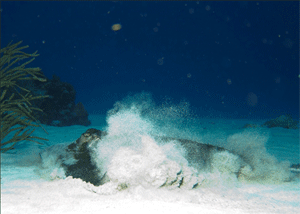
We will spend the night here at Desecheo and return tomorrow morning to Bajo de Sico for another round of deep dives, ROV sessions, and a shallow dive.
April 28th 2012
The seas were a little bit rougher this morning at Bajo de Sico. However, the deep rebreather divers made a go at it. They sampled and surveyed roughly the same area as yesterday: the northern gradual slope at 180-220ft (55-67m). Sponge samples relayed to the surface provided Nick Schizas and his crew a suite of invertebrates, but the topside infestation of crabs yesterday has given way to worms today, long polychaetes. The returning divers were ecstatic about the quality of the dive site. Doug Kesling believes that Bajo de Sico is an ideal candidate for year-round protections; currently, the site is seasonally protected from fishing. Milton Carlo observed a large Nassau grouper, and Ivonne Bejarano was gleaming with excitement over a large and curious hawksbill turtle. The divers encountered a large school of exceptionally large schoolmasters, and Miss Ichthyo-Hawk Eyes Ivonne spotted a nice tiger grouper hiding among them.
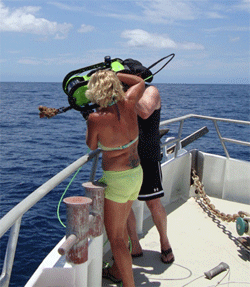
The seas were deemed too rough at Bajo de Sico today for the ROV and shallow divers. Thus, it was on to Tourmaline for the second half of the day. Tourmaline is the third seasonally protected area we have visited. The ROV session began prior to lunch. The ROV explored an area of sandy rubble with isolated sponges. Some bioturbation was observed again, but corals evaded the ROV this morning. At 59m (194ft), a few trails in the sandy rubble led to queen conch, quite deep for these gastropods. Colonies of garden eels were observed extending from and retracting into their burrows. The amusing sight conjured up memories of a groundhog arcade game. Francisco Pagan was behind the controls today and used the grabber to collect a deep sponge that yielded a common squat lobster for Nick Schizas.
The shallow divers were dropped in 45ft (14m) of water at Tourmaline. For one group of divers it became apparent that fish density at Tourmaline is habitat limited. After swimming south through an uneventful gorgonian colonized hard bottom, the group encountered a loosely colonized ledge that dropped 10ft and gave way to a sandy plain at 55ft (17m) deep. The ledge was full of cuts, undercuts, thru cuts, and all sorts and shapes of hiding places. It was like Alice’s Restaurant for fish seeking refuge and divers seeking a high density and wide variety of fishes. Large black margates, white margates, caesar grunts, French grunts, white grunts, tomtate, schoolmaster, dog snapper, gray snapper, chubs, lionfish, and much more—all schooling. A nurse shark, an amiable large hawksbill turtle, and a few spiny lobsters also made appearances. The other group of divers including the shallow rebreathers never made it to the ledge, and therefore, did not see the large concentration of fish. Their observations were less uplifting and included diseased corals, bleached corals, crushed conch shells, and encrusting sponges on dead corals. It is amazing just what a little shelter can provide in a not so healthy coral habitat. Is your glass half full?
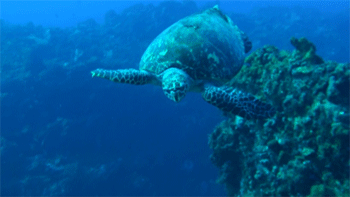
Oh yeah. Sure we can hit two sites with the ROV in one day. Site two…Manchas Exteriores, off northern Mayagüez, a suspected site for aggregating red hind earlier in the year. Why not just dive this site? Well it is near a sewage outfall. The site topography was remarkable, consisting of a shallow coral platform with steep walls down to 25m (82ft) with large outcrops and boulders. The scleractinian corals were all but absent except for the top of the platform where wave action likely removes the settling nutrient rich silt. However, there were black corals at depths of 15-25m (50-82ft). The entire site showed signs of high eutrophication. Thick algae and sponges encrusted the hard substrates and fine silt filled in the gaps. The site is quite impressive structurally and likely once was successful growing coral reef. Which begs the question: why did someone choose to put a sewage outfall here? It was worth viewing and luckily is close to tonight’s anchorage in the bay of Mayagüez.
April 29th, 2012
The deep rebreather divers dove a site near the eastern boundary of Tourmaline this morning. The samples collected contained living sponges, dead sponges, carbonate rocks, deepwater sea fans, and heavily encrusted empty conch shells. Yes, today no corals. The divers landed on the edge of a flat hard bottom that abruptly ended at a wall, which dropped from 125-175ft (38-53m) deep before meeting at a sediment ramp that continued downward. The divers spent most of their time exploring the sparsely colonized north-facing wall. The wall had no hard corals to speak of. Instead, the wall was covered with turf algae and trapped fine sediments, with interspersed sponges, gorgonians, and black corals. Not many fish were seen at this site. Ivonne noted one dog snapper. Nick Schizas and his posse processed and searched the retrieved sponges, rocks, shells, and gorgonians for fugitive vertebrate and invertebrate specimens. Polychaetes, bivalves, amphipods, isopods, shrimp, and fish were all successfully smoked out. Today’s samples produced two fish: a saw cheek cardinalfish and a translucent goby. The cardinalfish likely ditched its hiding spot in one of the old conch shells.
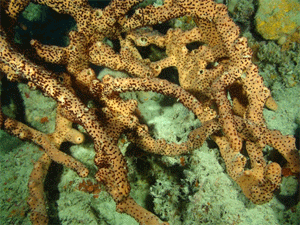
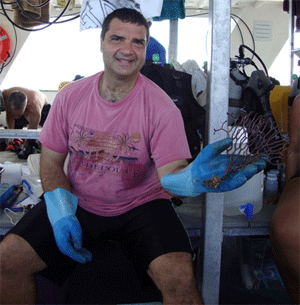
Late morning, the ROV scoped out a different spot within Tourmaline. At a depth of 70-75m (230-246 ft) the ROV zipped over a sandy bottom with intermittent single blade sea whips that at first glanced appeared to be the garden eels seen yesterday. When they did not retract into burrows and we moved in for a closer look, we saw they were sea whips, although the exact species has yet to be identified. Luckily, the ROV was able to surface with a sample for future identification. The sandy bottom had isolated oases of sponge, sea fan, and coral rubble. These locations provided shelter for black bar soldierfish, lionfish, jackknife fish, almaco jack, longsnout butterflyfish, and schools of blackfin snapper. Near the end of the dive, another oasis was located and approached. Great. Four more lionfish… then we saw a hovering haze just out of focus. The ROV pressed onward and revealed the source of the ill-omened haze, 100+ aggregating lionfish in an area less than 200m2. Intermixed with the lionfish was a red grouper. Many of us have never seen a red grouper in PR even though there are reports of red grouper in the past. Well, it has been confirmed red grouper are here and possibly inhabit the deep sandy rubble areas unfrequented by divers. Oh, you thought we would just brush over the lionfish sighting to talk about the red grouper? Groupers rule! But, yes, we located and recorded an unprecedented highly concentrated group of large lionfish in 72m (236ft) of water. What were these 100+ individuals doing together in a location with limited food resources? All we can say at this time is that it was fascinating.
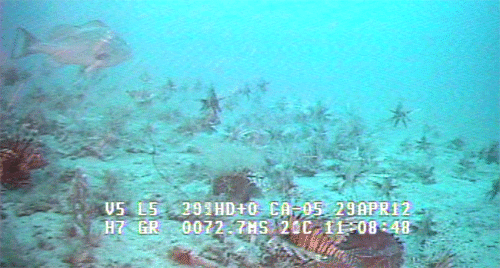
We returned to the same shallow dive site as yesterday so that everyone could appreciate all that “Alice’s Restaurant” had to offer. All divers found the ledge described by a few yesterday. Like yesterday, the site served up many of the same species and quite a few more. Among the new comers were glasseye snappers, yellow goatfish, slipper lobster, juvenile conch, barracuda, cero, bar jacks, crevalle jack, Atlantic spadefish, and nurse sharks. There were so many nurse sharks and lobsters today, one group counted 7 and 5 respectively, that we are tempted to change the name to shark lobster alley. The sure quantity of fish along this ledge is remarkable. The area serves as a superhighway for all these species, demersal, pelagic, large, medium, small, and sedentary. All are welcome. It is a good thing that this site is at least seasonally protected. Three derelict anchors were seen along the dive, indicating that this location is well fished from time to time. At the moment, the site is under the watchful eye of a near 5ft semi-aggressive barracuda. I wouldn’t be surprised if he takes his share of quota from the fishermen.
April 30th, 2012
After studying bathymetric data, the rebreather divers are to descend into the depths at a site south of Abrir la Sierra and north of Buoy 4 off Cabo Rojo. The divers landed on the top of the shelf platform where they located a well-colonized reef with minor spur and groove formations. The platform quickly gave way to a steep 60+ degree downward slope. The divers spent the dive along this slope collecting coral, sponge, and carbonate samples. The photo transect conducted by Doug Kesling and Clark Sherman contained a large slipper lobster. The slope was reported to be quite steep with hard outcrops and a few undercuts that housed some snappers and a juvenile yellowfin grouper. Turf algae, sponges, and sparse hard corals inhabited the substratum. The slope’s bottom is beyond the capabilities of the rebreather divers and continues to darker depths.
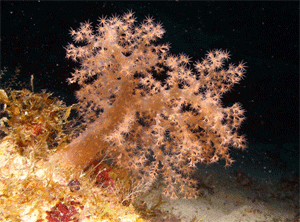
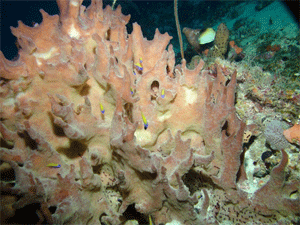
Due to deteriorating sea conditions and vessel generator issues, the ROV and shallow dives were cancelled on this last day of the first leg of the cruise. Now we head back to the sheltered waters of La Parguera, where we will be able to jump ship for a few days before reboarding Wednesday to head over to the U.S. Virgin Islands. Both the break and U.S.V.I. are worth looking forward to.
May 3rd, 2012
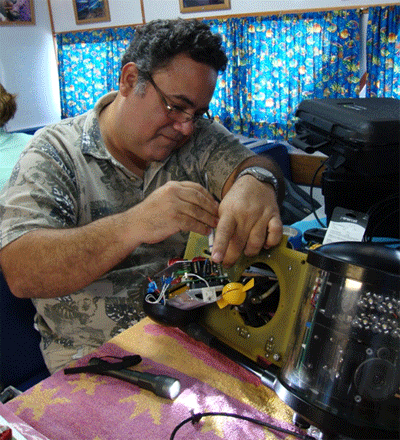
13:00, everyone is making their way back to the M/V Spree for the second leg of the mesophotic cruise. It appears that no one has jumped ship without authorization. Ivonne Bejarano and Daphne Pagan are not accompanying us for this second week. Do not get too sad though; we are luckily to have two new fresh sets of hands: Luis Rodriguez and Elizabeth “Shaun” Kadison. Luis boarded the ship this afternoon, and Shaun will be picked up in St. Croix tomorrow morning.
By 14:00, we had pushed off from the Magueyes Island dock in La Parguera. The destination is set to be St. Croix by early morning. We will take our time making the crossing, providing everyone plenty of time to prepare for our week in the Virgin Islands. Rich is charting our target dive areas, rebreathers are prepping equipment, and shallow divers/data processors are going over the plans for the week. Things appear to be shaping up quite well as the day comes to a close. The seas will be the lullaby tonight as we press onward to St. Croix.
May 4th, 2012
What a wonderful way to travel, fall asleep in PR and wake up in Frederiksted, St. Croix. We picked up Shaun Kadison early this morning at the Frederiksted pier on the west coast of the island. Next stop was the north coast at a site called Salt River. The history behind this site is interesting, both geologically and scientifically. Salt River is the remnant of an ancient river that flowed and cut a canyon when sea level was lower. Today, that steep canyon is submerged a maximum depth of 80m (262ft) in the center. Sounds like a great place for the rebreathers. Salt River is also the previous location of the Hydrolab, an underwater habitat that carried out scientific missions in St. Croix from 1977-1985. Today we will try to contribute to history of Salt River.
The rebreathers dove both the east and west sides of canyon down to a depth of 235ft (72 m). The divers reported seeing an additional wall at 300ft (90m) that dropped very steeply to depths unknown. Beyond 150ft (45m), corals were absent, which Michael Nemeth attributes to the “copious amount of clean sand” that flows down the slope. Two large mutton snapper, one lionfish, and two reef sharks were spotted on the dive. More lionfish were expected, but not seen. It is possible the various dive operations that utilize this site have been killing on sight. Specimens collected today included a suite of sponges, dead coral, carbonate rocks, and black coral. Specimens will be processed following the same protocol as last week. The variety of sponges collected today from the depths was the highlight. Nick Schizas was wondering where the corals have run to, until he talked with Michael. Conditions at this site do not support Agaricia spp. at mesophotic depths of >150ft (45m).
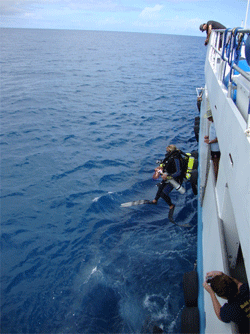
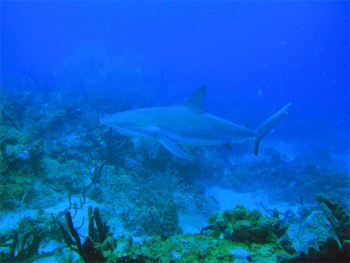
The ROV was next to dive Salt River. In 40m (131ft) of water the ROV encountered large and thick colonies of Agaricia undata. In between the colonies, the sediment Michael had described was visible. The density of live coral shallower than 50m (164ft) was impressive. After 50m, agarician densities fell and black corals began to appear along the deeper slope, with lots of nooks and crannies to search. Hmm, that makes me want an English muffin. The ROV dive was conducted off a fixed moored position and limited the dive to 50m unfortunately.
The shallow divers entered from the same mooring and dove down to 80ft (24m) this afternoon. As seen by the rebreathers in shallow depths, coral densities were surprisingly high compared to the sites dove in PR last week. Agaricia spp. were abundant as well as Montastrea spp. A mutton snapper or two stalked the divers throughout the entire dive. Schools of large yellowtail, creole fish, bar jacks, and brown chromis filled the pelagic waters above the reef. A few brown chromis and a large red hind were seen with isopods under the eyes. The more noteworthy observation was a school of a few hundred blackbar soldierfish, Myripristis jacobus. Their motives are unknown for this usually non-gregarious species. Evan Tuohy, one of the shallow rebreather, sacrificed a few lionfish to Poseidon (and gut content analysis). Two reef sharks quickly appeared to investigate the smell of death. Salt River was a great dive, but it’s getting late now so we best head to Christiansted for the night.
May 5th, 2012
Our brief time in Christiansted last night was well appreciated as it gave many of us a chance to see St. Croix for the first time. Now it is back to the high seas; actually it should be called the low seas because we have been blessed with some of the calmest weather. Hope it continues.
We returned to Salt River this morning for a 50m (164ft) deep rebreather dive. The goal was to document the structure and community at 50m. The divers observed and collected a few specimens of Agaricia undata, Agaricia larmarcki, and Agaricia fragilis. The thick colonies of Agaricia spp. recorded by the ROV yesterday were also seen today by the divers at depths less than 50m. The depth gradient of coral density at Salt River was reconfirmed by today’s shallower dive. Two samples of black coral, Antipathes sp. and Cirrhipathes sp., were also collected for Yahaira Hutchinson’s mucous and bacterial analyses. Doug Kesling led a few into shallow caves in the slope wall in a quest to find some sclerosponges. Michael Nemeth witnessed the disruption of a cleaning station involving yellowtail snappers being cleaned by a juvenile Spanish hogfish (Bodianus rufus). The presence of the strange terrestrial invaders brought an end to the spa treatment. It was a pleasure to dive this old river channel, but our work at Salt River has run dry. The next stop was the Lang Bank off the east end of St. Croix.
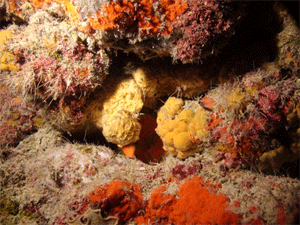
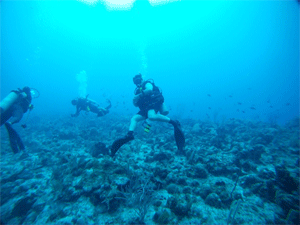
After lunch, the ROV took the plunge into the exceptionally calm waters of the Lang Bank for a series of two missions. The ROV cruised at a depth of 70m (230ft) along the northern drop of the bank. Corals were sparse along the slope, with occasional deep water gorgonians and black corals. Sponges, rhodoliths, and turf algae dominated the benthic community. Patches of Agaricia undata and Agaricia lamarcki were filmed, with A. lamarcki tending to inhabit shallower waters, <50m (164ft). Fish densities were low with no apex predators present. Red hind were the largest predators recorded.
The shallow divers dove an 80ft (24m) deep area of Lang Bank in the late afternoon. Spiny lobsters were plentiful in the crevasses of the low spur and groove formations. Sandy patches in the deeper grooves provided the habitat preference for a number of ocean triggerfish. Two nurse sharks were found sleeping and a hawksbill turtle glided in for a close-up. Francisco Pagan was fortunate to spot a rare Nassau grouper before it made a hasty retreat to a nearby hole in the reef. Evan Tuohy surfaced with seven lionfish to examine their gut contents. The big digestive reveal: a damselfish and multiple juvenile parrotfish. Montastrea cavernosa, Isophyllia sinuosa, Isophyllastrea rigid, Agaricia lamarcki, and Agaricia agaricites were collected for future analyses. A good variety of coral for collection, numerous fish for viewing, and the best visibility of the trip made it a great dive.
May 6th, 2012
We returned to the site of yesterday’s first ROV survey for the rebreather dive this morning. The divers dove to a depth of 180ft (55m) to conduct their photo-transect, specimen collection, video documentation, and fish survey. After the rebreathers reached their max depth of 180ft, they observed a change in the slope around 190ft (58m) where it abruptly dropped at a steeper degree. The divers found more coral than was previously surveyed with the ROV yesterday. Agaricia larmarcki, Montastrea cavernosa, and Antipathes pennacea were collected today and found to be in scattered patches of high density coral cover. Coneys were the dominant fish species surveyed. Red hind and a few mutton snapper were also observed. What appeared to be prime spiny lobster habitat contained no spiny lobsters. However, Milton Carlo found an exquisite red banded lobster, Justitia longimanus. It is one of the smaller lobsters in the area that actually have claws. Well, the males have claws, which Milton spotted on this individual. The red banded lobster was left to continue his happy life on the sea floor.
The ROV survey took us to depths greater than 70m (230ft) today at the Lang Bank. Francisco Pagan guided the ROV along the northern edge of the bank. Rhodoliths dominated the deep benthos. At depths of less than 50m (164), rhodolith abundance decreased and patches of healthy coral were observed in greater abundances. Agaricia spp., Meandrina meandrites, and Montastrea cavernosa were among the more abundant hard corals. The fish species seen today included queen triggerfish, blackfin snapper, schoolmaster, bluestripe grunt, lionfish, and sargassum triggerfish.
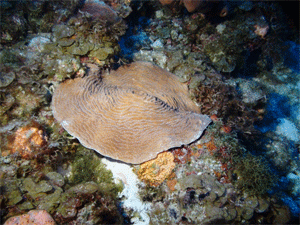
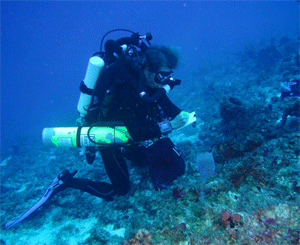
The shallow dive took us to the southern slope of the Lang Bank. The fish community mainly consisted of small reef fish. However, a small reef shark followed the shallow rebreathers, Evan Tuohy and Thor Dunmire, after they eliminated a large lionfish. Michael Dowgiallo counted 11 living conch as well as a number of harvested ones; one mature conch even had a fire coral thriving on its shell. The other shallow divers counted numerous spiny lobsters. Large coral colonies were absent, but small colonies were abundant and diverse. Nick Schizas collected a number of corals, including one rough star coral, Isophyllastrea rigida, for Derek Soto’s research. A few of us paid some attention to the echinoderms today. Nick Schizas and Timothy Rowell saw two beautiful golden crinoids, Davidaster rubiginosa. These feather stars are indeed echinoderms and boast bright orange tipped arms. The water clarity and lack of current allowed the divers to take their time and observe the smaller, but finer things on the reef.
May 7th, 2012
Davis Bay was the destination this morning. The scene was quite tranquil with calm blue waters that dropped beyond 300ft (91m) just offshore of a secluded beachfront resort. Everyone wanted to jump in the water immediately, but it was the deep rebreather divers that were dealt the winning hand. They descended to depths of near 300ft, one of the deepest dives of the trip. They anticipated they would be beyond the range of many hard corals, and the samples lifted to the surface confirmed this. Sclerosponges were some of the more precious specimens today. Sclerosponges are long-lived sponges that have a thin layer of tissue covering a hard skeleton. Due to the concentric deposition of their skeletons, they can record changes in oceanographic and atmospheric conditions during their long lives. They are fascinating organisms and scientific tools that Clark Sherman is exciting to examine. A number of beautiful deep sea gorgonians were collected, including orange deep water fans, Nicella goreaui. Many of the deep specimens today were welcomed by the intrigued eyes of the shallow divers.
The deep divers reported an absence of hard corals along the deep slope. Hard corals increased with decreases in water depth, and Agaricia lamarcki was collected from 150ft (45m) on the ascent. At 290ft (88m), blackfin snapper, mutton snapper, and schoolmasters were noted. Two reef sharks accompanied the divers during their decompression stops. On their way to the surface, the divers located a derelict cast net. As good ambassadors to the sea, the net was lifted to the surface and retrieved by the crew of the Spree. The net brought some excitement topside, yielding a batwing coral crab, a few shrimp, and a handful of mollusks. The net also released from its grasp a bright green marine leech. It was the first time many of us had ever seen a marine leech. We could not find any willing guinea pigs to confirm its vampire abilities.
You guessed it… the ROV was next to hit the water. The ROV descended along the Davis Bay shelf break, landing in a sandy plain at 45m (150ft) that continued northward till a more significant drop. The drop showed increasing evidence of heavy sediment movement down the wall, likely limiting the suitable habitat for coral colonization. From 70m downward, a layer of sediment covered a near straight down wall. Devil’s sea whip and sponges were common from 55-80m (180-264ft). Agaricia spp. were most abundant on the rocky spurs at 40-50mm (131-164m). An Agaricia humilis specimen was collected using the ROV’s grabber, and was retrieved for analyses by Nick Schizas. Fish species observed included black snapper, sargassum triggerfish, bluestripe grunt, surgeonfish, black margate, and Spanish hogfish.
Before we departed St. Croix for St. John, the shallow divers got their shot at Davis Bay. The dive was excellent for corals, but not so hot for fish. Agaricia spp., Mycetophyllia spp., Montastrea spp., Madracis sp., and many other coral species were seen in higher densities along the north facing wall than any of the sites previously dove on the mesophotic cruise. It was the first true wall dive of the trip for the shallow divers; remember, Salt River was technically a canyon dive. The corals stole the show today, but a number of smaller reef fish were seen. Graysbys were consistently the largest species seen with the exception of a few parrotfish here and there. The shallow rebreathers reported seeing blackfin snappers, schoolmasters, and a few grunts down at 120ft (36m). Mike Dowgiallo observed a banded butterflyfish with two female isopods and a soapfish who was resting on his side. Soapfish can appear so lazy sometimes. Nick Schizas returned to the surface with a number of coral samples, and Derek Soto returned with a lot of great coral photos. After diving in the outer shelf areas (>15miles (24km) offshore) of PR last week, it was amazing to be on a shelf drop less than 200m (650ft) from shore. St. Croix’s shelf is very narrow in most spots. Tomorrow in St. John, we should be back a little bit farther out to sea, which is not a problem if the seas remain like the lake we have been working on the last few days. I guess we will have to wait and see.
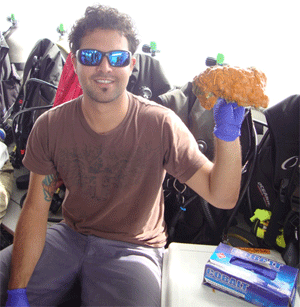
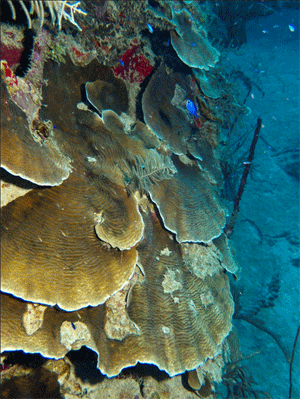
May 8th, 2012
The deep divers targeted a point along the shelf break near the St. John-British Virgin Island border. The site had decent coral cover along a steady downward slope. The slope had a series of ledges providing interesting habitat for fish, corals, algae, and sponges. Today the divers reached 175ft (53m) to carry out their usual tasks. The report was: this was one of the best dives of the trip, especially in regards to the fish present. A few small reef sharks were seen throughout the dive. Adding to the excitement were some dog snapper, cubera snapper, permit, and yellowfin groupers. Exquisite samples of Agaricia spp. were added to the trip’s collection.
The enthusiasm for the location was continued with the ROV deployment. The ROV explored the slope from 50-80m (164-262ft). The site provided many opportunities to record Agaricia spp. and Montastrea cavernosa. Hard corals, black corals, soft corals, and sponges were in higher abundances at deeper depths than many of our previous deep sites. Sedimentation was less visible at this offshore shelf edge than the near shore drops of St. Croix. A Stylaster roseus, rose lace coral, was found at 70m(230ft), deeper than expected. Additionally, a Montastrea faveolata was seen at 64m (210ft). The deep conditions at this site are suitable to support a variety of corals. A sample of feather black coral, Antipathes pennacea, was collected for genetic and bacterial analyses. Blackfin snapper, reef shark, lionfish, French grunt, queen triggerfish, red hind, and barracuda were among the fish du jour.
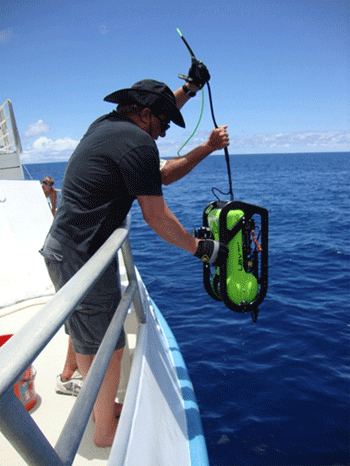
A second ROV mission explored an area farther west that had two slopes, the deeper of which began at 60m(197ft). Montastrea faveolata were recorded from 50-65m (164-213ft). Montastrea cavernosa and Agaricia spp. were found to depths beyond 87m (285ft), after which the wall abruptly drops. The depths to which above average densities of Agaricia spp. were found was remarkable. This second site would be an excellent candidate for tomorrow’s deep dive.
Today’s shallow dive was extraordinary. The dive was along a near shelf edge ledge in 80-90ft (24-27m) of water. The ledge was a mecca for marine life, supporting a large school of exceptionally large schoolmasters, a hawksbill turtle, three reef sharks, multiple large and terminal phase hogfish, a yellowfin grouper, a tiger grouper, a few dog snappers, a couple of large cubera snapper, and many other usual suspects, including lionfish. So yes, the fishes kind of stole the show, but there were a lot of small and healthy coral colonies. Derek Soto led the collecting charge today with 15 Montastrea cavernosa, and as usual Nick Schizas wielded the hammer in the name of science. Mike Dowgiallo found what quite possibly is the largest slipper lobster in the USVI; it was a monster. Everyone surfaced ecstatic and agreed that the marine life combined with the incredible water clarity made this the most superb dive of the trip. We are wondering… can we beat it tomorrow?
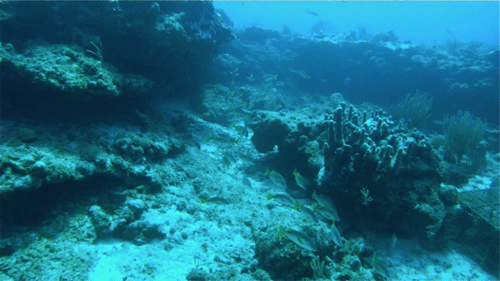
May 9th, 2012
We returned to yesterday’s second ROV location off the east side of St. John for this morning’s deep rebreather dive. The divers enjoyed their last dive of the mesophotic trip, which had exceptionally deep coral colonies as noted by the ROV yesterday. Milton said that the site was remarkable, with typical coral distributions shifted 50ft (15m) deeper than usual. Not only were coral colonies thriving in these depths, but they were also abundant. Fascinating! The site also supported large numbers of fish, including yellowfin grouper, tiger grouper, cubera snapper, and dog snapper. A number of samples were collected at 70m (230ft) and 50m (164ft). The shelf area surveyed today is a prime example of reef community diversity in the Caribbean, and as Doug Kesling noted, it would be an excellent candidate for a future marine protected area.
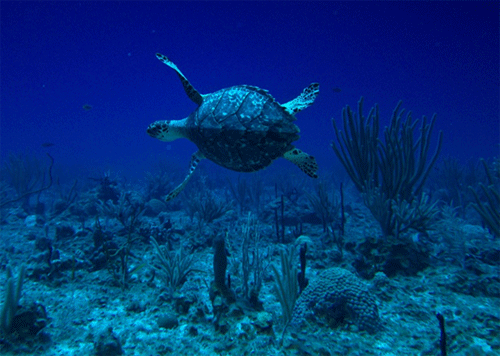
The shallow dive took place before lunch today at a location not too far off from the site of the deep dive. As the divers landed on the shelf break ridge, a large nurse shark joined the group for a few minutes, swimming amongst the newcomers. The habitat consisted of hard bottom with small coral colonies and gorgonians at a depth of 80-90ft (24-27m). Water clarity was exceptional along the ridge, allowing for viewing opportunities of the landward mid-shelf basin. Three hawksbill turtles were observed together as if they were in a meeting. Two of the turtles scattered, but the remaining individual stuck around for Q&A, photos, and video. The shallow rebreather team crossed the ridge and made it to the seaward shelf drop, where higher densities of corals and large fish were encountered, such as red hind. The last coral samples of the trip were collected during this dive, rounding off our comprehensive coverage from PR to the USVI.
The last stop was the Grammanik Bank, a protected area off St. Thomas, for some fun with the ROV. Depths up to 87m (285ft) were visited, yielding some great video of the deep reef off the shelf break slope. Agaricia spp. were abundant from 83m (272ft) upward, forming large overlapping plates loosely attached to the sea floor. Areas of near 100% Agaricia undata cover were located at 66m (216ft). The scene was spectacular and drew the attention of everyone on board. Five schooling yellowfin grouper were seen patrolling the thick areas of Agaricia undata. The offshore current limited the bottom time and ability to observe the slope closely, but from what we saw we were thoroughly impressed. As Richard Appeldoorn said, there was something for everyone: fish, corals, and currents. A sample of a black coral sea fan was retrieved for Nick Schizas. The sample was more than just a coral sample; the sea fan was a host habitat for sponges, algae, and bivalves. The excitement was almost too much to handle for the invert team.
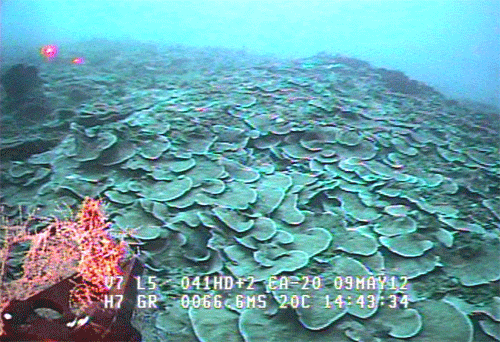
What a trip! We all had a blast and got a lot of great work done, but we are a bit tired. Now it is time to steam back to La Parguera and begin the land-based work. We have plenty of data, samples, and reports to analyze. Till then, we will enjoy each other’s company for one last night before we hit the bunks and wake up tomorrow back in familiar waters.
